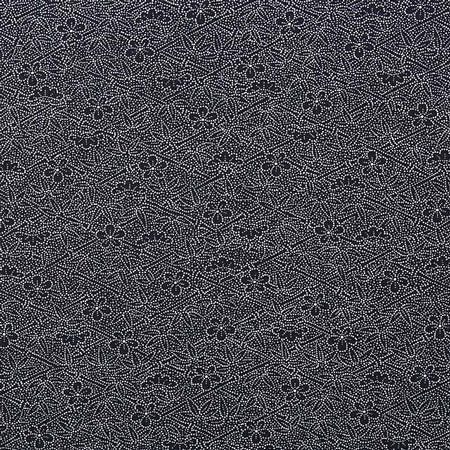Edo Komon: Chitchat

Edo Komon is a dyeing technique for intricate patterns that developed primarily among the samurai class during the Edo period , and its origins were heavily influenced by the competitive spirit of the feudal lords.
During the Edo period, the shogunate repeatedly issued frugality edicts, restricting the wearing of extravagant clothing, especially for feudal lords and the samurai class. However, feudal lords sought ways to show their status even within these restrictions, and it is said that this resulted in the evolution of Edo Komon techniques.
The origin of Edo Komon dates back to the kamishimo (traditional Japanese kimono) worn by samurai during the Warring States period.

Feudal lords originally wore kamishimo with large dyed family crests. However, as laws banning luxury became stricter, flashy decorations were restricted and it became difficult to display large family crests.
So instead of using family crests, feudal lords began to arrange small patterns based on their family crests in detail all over the kamishimo. This resulted in a stylish and sophisticated design that looks plain from a distance, but when you look closer you can see the family crest or unique pattern woven into it. This idea became one of the origins of the characteristically detailed patterns of Edo Komon.
For example, there is the "Shark Small Crest" of the Kishu Domain, the "Gyogi Small Crest" of the Sendai Domain, and the "Kaku-tsuri Small Crest" of the Hikone Domain.

The more detailed and intricate the patterns, the more advanced the skills required. Thus, feudal lords began to compete with each other, and more intricate and beautiful patterns were demanded, leading to a dramatic development in Edo Komon techniques.
The evolution of dyeing techniques using stencil patterns also contributed greatly to the development of Edo Komon.
Ise Katagami, developed in the Ise region (present-day Mie Prefecture), was capable of carving extremely intricate patterns and became an important element in supporting the precision of Edo Komon. Craftsmen used these stencils to apply a dye-resistant paste to the fabric, and made full use of techniques such as indigo and crimson dyeing to create beautiful Komon. These technological advances enabled feudal lords to compete with each other for more advanced designs.
Eventually, the techniques of Edo Komon spread beyond the samurai class to townspeople culture as well.
In particular, the townspeople of Edo valued elegance and style, and preferred intricate patterns that appeared modest on the surface but revealed themselves when they got closer. This aesthetic sense encouraged the further development of Edo Komon, and it came to be widely worn by the common people of Edo. Thus, Edo Komon evolved from being merely a means of showing the status of feudal lords to a dyeing technique that symbolized Edo culture.

Today, Edo Komon is passed down as a traditional craft and is used on kimonos, obi, accessories, etc., as well as in modern fashion. This sophisticated technique, born out of the competitive spirit of feudal lords, continues to be loved by many people across the ages.

